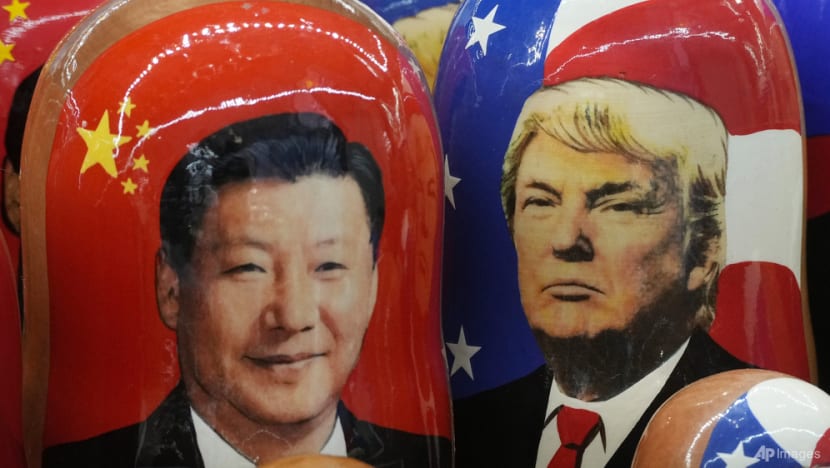Commentary: As US and China dig in on tariffs, this is no longer just a trade war
While Donald Trump threatens more tariffs and Xi Jinping turns on the charm, Southeast Asian nations will have to navigate between the two while preserving as much autonomy as possible, says Enodo Economics’ Diana Choyleva.


This audio is generated by an AI tool.
LONDON: If the US-China trade war has become a big game of chicken, who will be the first one to blink?
As the dust settles on the latest round of tariff salvos between the world's two largest economies, one thing is clear for everyone else: This all-out economic confrontation will rapidly force countries to choose their economic allegiance.
Beijing's response to US President Donald Trump’s tariffs has been swift and pointed. After several tit-for-tat retaliations – bringing US duties on Chinese goods to a staggering 145 per cent and Chinese tariffs on US imports to 125 per cent – China said it would ignore further hikes in a “numbers game” that “will become a joke".
Don’t count on China blinking first. Beijing sees no reason to mollify the US.
For President Xi Jinping, there was always only one politically viable response to Mr Trump's provocations: strength. Having already surprised domestic audiences with a forceful initial reciprocal tariff, any appearance of backing down would be politically untenable.
Yet Beijing's response suggests strategic patience rather than reckless escalation. Chinese leadership appears prepared to endure the economic confrontation, confident that mounting domestic pressure within the US will eventually force the Trump administration to the negotiating table on terms more favourable to China.
This patient approach aligns with traditional Chinese strategic thinking. By allowing economic gravity to do the work as American consumers and businesses absorb the inflationary shock, Beijing can project strength while exercising relative restraint.
The question is whether China can afford this strategy given its current economic challenges.
CHINA'S ECONOMIC RESILIENCE
Despite grappling with significant headwinds – overinvestment, excessive debt levels, and persistently weak domestic demand – China enters this trade confrontation with multiple structural advantages that strengthen its position.
First, Beijing enjoys considerable political stability compared to Washington. While Mr Trump confronts the constraints of democratic politics and election cycles, China’s Communist Party operates without such limitations. This gives Chinese leadership the ability to weather short-term economic pain for long-term strategic gain.
Second, China's centralised governance allows for coordinated deployment of all available policy tools. Unlike the fragmented American system where monetary policy remains independent from fiscal decisions, Chinese leadership can simultaneously pull all economic and financial levers. Beijing possesses substantially greater fiscal headroom and monetary flexibility to cushion trade impacts.
Most importantly, China has deliberately kept substantial monetary and fiscal reserves dry in anticipation of this exact scenario – and is now poised to deploy them aggressively. The People's Bank of China is expected to implement multiple reserve requirement ratio cuts alongside targeted credit easing measures, while fiscal authorities will front-load planned expenditures with particular emphasis on employment support for the export sector.
Far from dooming China to a middle-income trap, this trade war may actually accelerate Beijing's planned economic pivot toward domestic consumption. The party’s flagship newspaper People's Daily has already framed this crisis as a strategic opportunity to establish "domestic demand as a long-term strategy" with "consumption as the main engine and stabiliser of economic growth".
AMERICA'S SELF-INFLICTED WOUNDS
For the United States, the immediate economic calculus appears far less favourable. Mr Trump's aggressive implementation timeline creates significant inflation risks that directly contradict his campaign pledges to lower prices for American consumers.
His administration's intent remains clear. Washington appears determined to seal off alternative routes for Chinese goods entering the US market.
Even with the current pause on “reciprocal” tariffs, the inflation risk remains genuine. If Chinese goods cannot be effectively rerouted through third countries as they were previously, US consumers will inevitably face price increases across household goods, electronics and apparel.
Moreover, the way Mr Trump has framed bilateral trade flows solely in terms of volume ignores another crucial aspect – the asymmetry in the types of goods traded between US and China. Chinese imports from America predominantly consist of manufacturing inputs and equipment, insulating Chinese citizens from immediate price shocks. But American households will directly bear the burden of higher prices on everyday consumer products imported from China.
More immediate and visible economic pain for Mr Trump's electorate will potentially undermine political support for continued confrontation. His recent decision to exempt smartphones and other consumer electronics from the steepest reciprocal tariffs reflects this.
A BIFURCATED GLOBAL ECONOMY
What we are witnessing is not merely a trade dispute but the acceleration of global economic bifurcation – a process that was already underway but has now shifted into overdrive.
The Trump administration reportedly plans to put pressure on trading partners to curb trade with China in exchange for tariff concessions.
This new reality is particularly stark for Southeast Asian nations caught in the crossfire. Having prospered by straddling both economic spheres, countries like Vietnam, Thailand and Indonesia now face pressure to choose between continued access to American consumers or maintaining deep integration with Chinese supply chains.
Mr Xi’s visit to Vietnam, Malaysia and Cambodia this week was planned long before the tariffs were announced, but his charm offensive has now taken on a new sense of urgency.
While all three countries will continue trying to hedge between the US and China, each faces distinct pressures. Geographical proximity and economic dependence give China clear leverage, but strategic alignment remains complex.
Vietnam harbours deep historical distrust toward China, yet may ultimately lean toward Beijing given economic interdependence. Cambodia, though increasingly wary of overreliance on China, remains closely tied to it. Malaysia, meanwhile, could tilt toward the US, shaped in part by domestic sensitivities around its ethnic Chinese minority and a desire to balance external influence.
Despite their differences, none of these states will choose sides lightly. But when forced, the alignments may not be where they first appear, especially as China steps up its charm offensive while the US under a more confrontational Trump makes it harder to win regional trust.
In this emerging economic landscape, between the two poles stand critical swing players like the European Union and India, whose ultimate alignment will substantially shape the new order.
The EU appears to be hedging its bets with increasing sophistication. China-EU trade negotiations have restarted "with a strong top leadership push". For China, the EU represents a critical counterbalance to US economic pressure. For the EU, deeper engagement with China offers leverage in negotiations with Washington while potentially securing concessions on market access.
India, with its massive market and growing manufacturing base, is making calculated moves that reveal its complex position in the emerging bifurcation. Senior Indian officials have adopted a conciliatory tone towards the US, yet this eagerness for a US trade deal appears more political than economic: India's exports to the US represent just 3 per cent of gross domestic product, making it relatively insulated from tariff impacts.
The imperative for countries, companies and investors is clear: understand which bloc offers the best strategic fit, or develop sophisticated strategies to operate across an increasingly divided global economy.
For Singapore and other Southeast Asian nations, the challenge will be particularly acute: navigate between these competing economic spheres while preserving as much autonomy as possible.
The trade war has moved beyond simple economic competition into a fundamental restructuring of the global economic order. Those who recognise and adapt to this new reality of a bifurcated global economy will be best positioned to thrive in the challenging years ahead.
Diana Choyleva is the founder and chief economist of Enodo Economics and a senior fellow at the Asia Society Policy Institute’s Center for China Analysis.



















